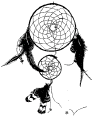Having performed this bloody deed, he loaded a gun, and
placing himself behind the gate of the "Fort," he awaited anxiously the
return of his unsuspecting master, whom, as he entered the gateway, he shot
in the back, causing his immediate death. He next murdered the eldest child,
a girl about six years of age, and was proceeding to finish his bloody work
by taking the life of the youngest, when his black heart misgave him. The
child had been his pet, and was just beginning to run about and lisp its
childish prattle, and at first he could not find it within him to take its
innocent life. His qualms of conscience, however, did not last long, for
becoming tired of its ceaseless cries for its parents, after he had
preserved its life three days, he murdered the little one in cold blood, and
made its grave with his other victims in a heap of shavings and other
rubbish, which had accumulated in a corner of the Fort.
This bloody tragedy was perpetrated in the spring of the
year, when the Indians were all away at their sugar camps on the main shore,
and at a time when the ice on the lake had become so weak and rotten as to
make it unsafe to cross or travel on it. Notwithstanding the state of the
ice, the guilty man, who could not bear to remain in solitude surrounded
with the evidences of his bloody deed, attempted to make his escape, but
having twice broken through the ice, and with difficulty saved his life, and
(as he confessed) being drawn back by an invisible power, he returned to the
scene of his crime, to patiently await its consequence.
When the ice had disappeared and melted away under the
rays of the spring sun, the Indians once more frequented the Fort, and on
their inquiring for the trader, the murderer told them the plausible story,
that his master had started with his family on a dog train, while the ice
was still on the lake, to pay them a visit at their sugar camps. And as he
had never arrived amongst them, all naturally supposed that he had broken
through the bad ice, and drowned with his family. The Ojibways faithfully,
hunted the shores of the island and adjacent main land, for the remains of
their lost trader, but as may be supposed, they searched in vain.
In the course of the spring a light canoe arrived from
Montreal by way of Grand Portage, containing one of the factors of the fur
company, to who belonged the post.
At first the plausible tale of the murderer was credited,
but marks of blood having been discovered on the walls of the room where the
trader's wife had been murdered, and his evident confusion on being asked
the cause of them, led immediately to suspicion, and he was from that time
arrested and confined.
Shortly after this, the factor, while walking around the
precincts of the fort, endeavoring to discover further traces of the murder,
happened to push his sword cane into the pile of rubbish where the murderer
had buried the bodies of his unfortunate victims, and the stench on the end
of his canted to a complete discovery. The bodies were immediately
disinterred in presence of the guilty wretch, who now confessed his crime.
The fort was evacuated, and the cannon and iron works were thrown into the
adjacent pond, which having a deep and miry bottom, they have never been
discovered by the Indians, who often afterwards searched for them. The site
of this old post is still plainly discernible from small mounds of stone and
rubbish, which once formed the chimneys of the dwellings, which are still to
be found on the spot where it once stood. The murderer was taken to
Montreal, and the Indians at this day say that he was torn to pieces by
horses being attached to each of his arms and legs, and caused to pull in
different directions.
Another account has it, and coming from the lips of old
traders and half-breeds, I am disposed to believe it as the truth, that the
guilty wretch managed to escape from his keepers on the route to Montreal,
and seeking refuge among the Hurons, he adopted their dress and customs, and
learned to speak their language. On one occasion being present at a
war-dance, when the Indian warriors were striking the "red stake" and
telling their different exploits performed in war against their enemies, the
murderer stepped into their midst, and likewise striking the stake, he
related his deed of treachery and blood, expecting to be honored by the red
men as a brave man, for the exploit. He was however mistaken, for before he
had finished his tale of the bloody deed, an Indian warrior arose, and
stepping up to him with the single exclamation of "Dog," he buried a
tomahawk deep into his brain. The narrative of this event has been carefully
preserved and handed down by the old traders, and it is presented here as I
have learned it from them.
The tale as the Indians tell it, is somewhat mixed with
the superstitious and unnatural, though in the main incidents they fully
agree with the trader's account. They give as a cause for the murder, that
the "Coureurs du Bois" had pilfered goods during the winter to such an
amount that his master threatened to report his conduct to the Factors on
their first visit, and have him taken to Quebec as a culprit. To prevent
this disgrace and punishment, the man first killed his master, as has been
related, and then attempted rape on his wife, who forced him to kill her by
her active self-defense with the Indian spear. Only in this respect do the
Indians differ in the account from that which I have given, and which is
said to have been the confession of the murderer himself. (This story as
told by the trader, William Morrison, in August 1822, appeared in the
Detroit Gazette, and is reprinted in Vol. VIII. Of Wisconsin Historical
Collections. The published account says the tragedy of killing the traders
his wife and child, occurred during the winter of 1760--61, and that on his
way to Montreal for trial he was released on the St. Lawrence River, and
fought with the Indians against the British. His boasting of his murders
took place at a dance near Sault Ste. Marie. The Indians, disgusted with his
tale of cruelty, invited him to a feast, and as soon as he commenced to eat,
he was informed by the chief that as soon as he stopped, he would be killed.
He ate for a long time, but at last had to stop, when he was soon lifeless.
His body was boiled, but the young men would not eat, for they said "he was
worse than a bad dog."--E. D. N.)
I learn from Michel Cadotte, and the venerable John
Baptist Corbin, who came into the Ojibway country when he was twenty years
of age and has remained fifty-six years, that this event occurred just one
hundred and thirty years ago, in the year 1722.
go to chapter 10
1
- 2
- 3
- 4
- 5
- 6
- 7
- 8
- 9
- 10
11
- 12
- 13
- 14
- 15
- 16
- 17
- 18
- 19
- 20
21
- 22
- 23
- 24
- 25 - 26 - 27 - 28 - 29 - 30
White Eagle Soaring: Dream Dancer of the 7th Fire







 Get
a course to promote your business online, explode your sales
Get
a course to promote your business online, explode your sales Get
software to promote your business online in less time
Get
software to promote your business online in less time Get
software to streamline your business and run it hands free.
Get
software to streamline your business and run it hands free.